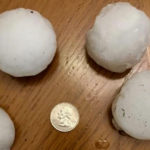And in Springtime, that means really big hail.

 Last night, less than one week into Spring, the first large hail storm swept in from Oklahoma, covering an area from Sherman to Denton.
Last night, less than one week into Spring, the first large hail storm swept in from Oklahoma, covering an area from Sherman to Denton.
There were reports of hail stones as large as baseballs and softballs. Many areas reported golf ball sized or larger. While the damage caused by such a storm can be severe, it’s far too often only made worse by unscrupulous people preying on those dealing with the storm’s aftermath.
According to the Texas Department of Insurance, fraud after a storm like this “can range from shoddy repairs to price gouging. In the worst cases, people offering services to storm victims may simply take their money and run.”
How Can You Avoid Fraudulent Storm Damage Contractors?
- Start with a call to your insurance company to get an appraisal on what your repairs should cost.
- Use local companies and check their references and contact numbers.
- Get written estimates. These should be on the company’s letterhead with clear contact information.
- Get more than one bid. This will help you gauge which offers are legitimate and which may be too high or too good to be true.
- Don’t pay the full amount in advance. Legitimate contractors may require a partial payment up front to get started, but your final payment should not be made until the job is finished.
- If you feel pressured or threatened, call the police.
Public Adjusters
Another concern is fraudulent activity by licensed public insurance adjusters and unauthorized individuals or entities acting as public insurance adjusters. Texas law prohibits public adjusters from participating in the repair process to prevent conflicts of interest. For example, roofers may not act as public insurance adjusters, or advertise that they will handle the insurance claim for you.
Report Insurance Fraud
If you have information about insurance fraud, file a complaint with TDI’s Fraud Unit online or by calling 1-800-252-3439.
If you’re an iMGA agent, make sure all your Dwelling, Homeowners, MobileHome, Renter and Vacant personal property insurance customers are properly covered.
If you’re not yet an iMGA agent, go ahead and start the process to become one now.

